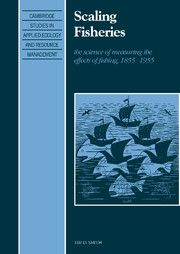Book contents
- Front Matter
- Contents
- Acknowledgements
- Preface to the Paperback Edition
- References
- Units used in the text
- Part I INTRODUCTION
- Part II DEVELOPING METHODS, 1855–1940
- Part III THREE PARTIAL THEORIES, 1940–1955
- 7 Middling in size
- 8 How many parents are enough?
- 9 Steady state yield
- 10 Integration: self-regenerating populations and the bionomic ecosystem
- Notes
- References
- Index of people
- Subject index
8 - How many parents are enough?
Published online by Cambridge University Press: 22 September 2009
- Front Matter
- Contents
- Acknowledgements
- Preface to the Paperback Edition
- References
- Units used in the text
- Part I INTRODUCTION
- Part II DEVELOPING METHODS, 1855–1940
- Part III THREE PARTIAL THEORIES, 1940–1955
- 7 Middling in size
- 8 How many parents are enough?
- 9 Steady state yield
- 10 Integration: self-regenerating populations and the bionomic ecosystem
- Notes
- References
- Index of people
- Subject index
Summary
The one all-important remedy … is to permit more fish – many more fish – to … become spawners.
Charles Gilbert 1918Garstang criticized the International Council for the Exploration of the Sea (ICES) analysis of the effects of the First World War by suggesting that a higher abundance of large plaice on the fishing grounds might increase the competition between the adults and the juveniles, causing the latter to grow more slowly (Garstang 1926). Elton at Oxford noted in his 1927 book Animal ecology (p. 50) the Chinese proverb ‘the large fish eat the small fish,’ another way in which a higher abundance of adults might affect the success of juveniles. The effects of adults competing with or preying on their offspring are examples of what Lankester had termed ‘complex interactions’ when he addressed the International Fisheries Exhibition in 1883 (see chapter 2), interactions that could be extremely important if the numbers of spawning fish became too high. On the other hand, the effect of increasing fishing is generally to reduce the number of spawning fish, and as Gilbert had noted after the failure of the expected large 1917 run of sockeye salmon in the Fraser River (see chapter 1), sometimes there were too few spawners. In the 1940s the problem of the effects of spawning fish on the abundance of their offspring became an issue in two different fisheries, the Georges Bank haddock fishery and the still struggling Fraser River sockeye fishery.
- Type
- Chapter
- Information
- Scaling FisheriesThe Science of Measuring the Effects of Fishing, 1855–1955, pp. 267 - 292Publisher: Cambridge University PressPrint publication year: 1994

